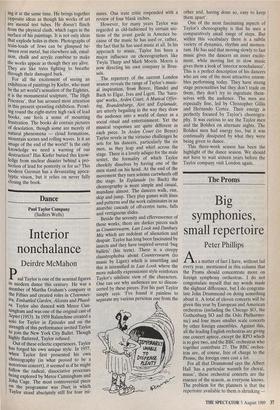Paul Taylor Company (Sadlers Wells)
Interior nonchalance
Deirdre McMahon
Paul Taylor is one of the seminal figures in modern dance this century. He was a member of Martha Graham's company in the Fifties and created roles in Clytemnes- tra, Embattled Garden, Alcestis and Phaed- ra. Taylor also danced with Merce Cun- ningham and was one of the original cast of Septet (1953). In 1959 Balanchine created a solo for Taylor in Episodes and on the strength of this performance invited Taylor to join the New York City Ballet. Though highly flattered, Taylor refused. Out of these eclectic experiences, Taylor has forged his own unique style. In 1957, When Taylor first presented his own choreography (in what proved to be a notorious concert), it seemed as if he might follow the radical, dissociative processes being explored by Merce Cunningham and John Cage. The most controversial piece on the programme was Duet, in which Taylor stood absolutely still for four mi- nutes. One irate critic responded with a review of four blank inches.
However, for many years Taylor was regarded as old-fashioned by certain sec- tions of the avant garde in America be- cause of the music he has used or, rather, the fact that he has used music at all. In his approach to music, Taylor has been a major influence on choreographers like Twyla Tharp and Mark Morris. Morris is now directing his own company in Brus- sels.
The repertory of the current London season reveals the range of Taylor's music- al inspiration, from Boyce, Handel and Bach to Elgar, Ives and Ligeti. The 'baro- que' works, Arden Court, A Musical Offer- ing, Brandenburgs, Airs and Esplanade, are utterly beguiling in the way they draw the audience into a world of dance as a social ritual and entertainment. Yet the musical responses are quite different in each piece. In Arden Court (to Boyce) Taylor revels in the virtuoso challenges he sets for his dancers, particularly the six men, as they leap and whirl across the stage. There is a lovely adagio for the male sextet, the formality of which Taylor cheekily dissolves by having one of the men stand on his head. At the end of the movement they turn solemn cartwheels off the stage. In Esplanade (to Bach) the choreography is more simple and casual, mundane almost. The dancers walk, run, skip and jump. They play games with lines and patterns and the work culminates in an anarchic cascade of off-centre turns, falls and vertiginous slides. Beside the serenity and effervescence of these works, there are darker pieces such as Counterswarm, Last Look and Danbury Mix which are redolent of alienation and despair. Taylor has long been fascinated by insects and they have inspired several 'bug ballets' (his term). There is a creepy claustrophobia about Counterswarm (to music by Ligeti) which is unsettling and this is intensified in Last Look where the more nakedly expressionist style reinforces Taylor's nihilistic view of the characters. One can see why audiences are so discon- certed by these pieces. For his part Taylor simply says: 'I've found it painless to separate my various personas one from the other and, having done so, easy to keep them apart'.
One of the most fascinating aspects of Taylor's choreography is that he uses a comparatively small range of steps. But within this vocabulary there is a subtle variety of dynamics, rhythm and momen- tum. He has said that moving slowly to fast music gives the dancers an inner excite- ment, while moving fast to slow music gives them a look of 'interior nonchalance'. This is a perfect description of his dancers who are one of the most attractive ensem- bles performing today. They have strong stage personalities but they don't trade on them; they don't try to ingratiate them- selves with the audience. The men are especially fine, led by Christopher Gillis and Hernando Cortez. Their energy is perfectly focused by Taylor's choreogra- phy. It was curious to see the Taylor men and the Bolshoi on alternate nights. The Bolshoi men had energy too, but it was continually dissipated by what they were being given to dance.
This three-week season has been the highlight of the dance season. We should not have to wait sixteen years before the Taylor company visit London again.


















































 Previous page
Previous page